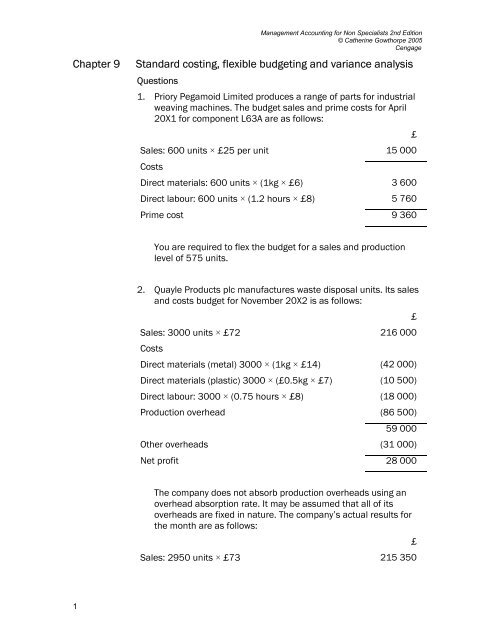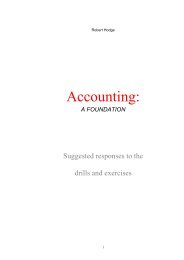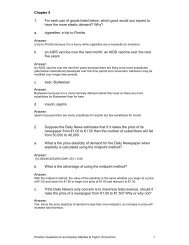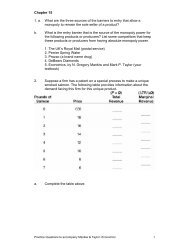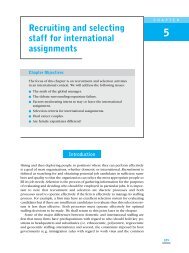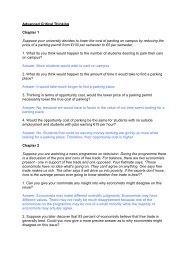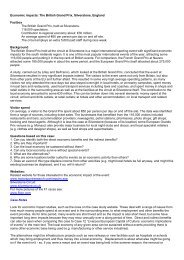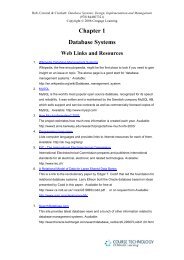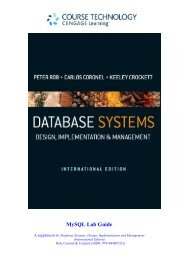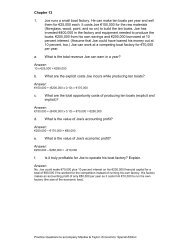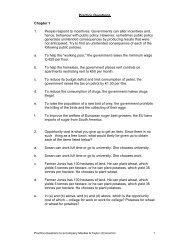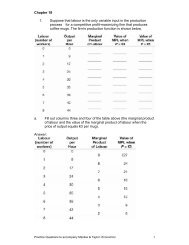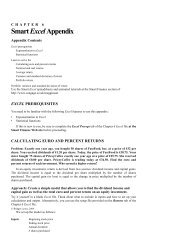Chapter 9 Standard costing, flexible budgeting and variance analysis
Chapter 9 Standard costing, flexible budgeting and variance analysis
Chapter 9 Standard costing, flexible budgeting and variance analysis
You also want an ePaper? Increase the reach of your titles
YUMPU automatically turns print PDFs into web optimized ePapers that Google loves.
<strong>Chapter</strong> 9Management Accounting for Non Specialists 2nd Edition© Catherine Gowthorpe 2005Cengage<strong>St<strong>and</strong>ard</strong> <strong>costing</strong>, <strong>flexible</strong> <strong>budgeting</strong> <strong>and</strong> <strong>variance</strong> <strong>analysis</strong>Questions1. Priory Pegamoid Limited produces a range of parts for industrialweaving machines. The budget sales <strong>and</strong> prime costs for April20X1 for component L63A are as follows:£Sales: 600 units × £25 per unit 15 000CostsDirect materials: 600 units × (1kg × £6) 3 600Direct labour: 600 units × (1.2 hours × £8) 5 760Prime cost 9 360You are required to flex the budget for a sales <strong>and</strong> productionlevel of 575 units.2. Quayle Products plc manufactures waste disposal units. Its sales<strong>and</strong> costs budget for November 20X2 is as follows:£Sales: 3000 units × £72 216 000CostsDirect materials (metal) 3000 × (1kg × £14) (42 000)Direct materials (plastic) 3000 × (£0.5kg × £7) (10 500)Direct labour: 3000 × (0.75 hours × £8) (18 000)Production overhead (86 500)59 000Other overheads (31 000)Net profit 28 000The company does not absorb production overheads using anoverhead absorption rate. It may be assumed that all of itsoverheads are fixed in nature. The company’s actual results forthe month are as follows:£Sales: 2950 units × £73 215 3501
Management Accounting for Non Specialists 2nd Edition© Catherine Gowthorpe 2005CengageCostsDirect materials (metal) 2950 × (0.9kg × £13.80) (36 639)Direct materials (plastic) 2950 × (£0.5kg × £7.20) (10 620)Direct labour: 2950 × (0.7 hours × £8.20) (16 933)Production overhead (84 250)66 908Other overheads (32 250)Net profit 34 658You are required to:(a) calculate:(i) sales profit volume <strong>variance</strong>(ii) sales price <strong>variance</strong>(iii) materials price <strong>variance</strong> (for both metal <strong>and</strong> plastic)(iv) materials quantity <strong>variance</strong> (for both metal <strong>and</strong> plastic)(v) direct labour rate <strong>variance</strong>(vi) direct labour efficiency <strong>variance</strong>(vii) overheads <strong>variance</strong>s(b) prepare a st<strong>and</strong>ard cost operating statement(c) suggest reasons for any price <strong>variance</strong>s you have calculated.3. Robertson Rix Limited is a manufacturing company. In January20X6 it budgeted for 1500 units of production, each of whichuses 2.25 hours of machine time. Production overheadabsorption rates had been budgeted as follows for the financialyear:Variable production overhead £6 per machine hourFixed production overhead £7.80 per machine hourThe actual level of production in the month was 1520 units. Theactual expenditure on variable production overhead in the monthwas £21 360. The actual expenditure on fixed productionoverhead in the month was £26 201.You are required to calculate:(a) the variable production overhead <strong>variance</strong>(b) the fixed production overhead <strong>variance</strong>2
Management Accounting for Non Specialists 2nd Edition© Catherine Gowthorpe 2005Cengage4. Selly Watkins plc makes bathroom fittings. The directors havemonthly board meetings at which, amongst other things, theydiscuss the most recent st<strong>and</strong>ard cost operating statement. Thestatement for April 20X3 reads as follows:Original budgeted netprofitSales profit volume<strong>variance</strong>Total£216 7605 866Flexed budget net profit 222 616Other <strong>variance</strong>s Favourable (Adverse)£ £Sales price <strong>variance</strong> (2 689)Direct materials price<strong>variance</strong>8 760Direct materials quantity<strong>variance</strong>Direct labour rate<strong>variance</strong>Direct labour efficiency<strong>variance</strong>Variable overhead<strong>variance</strong>— —660(9 989)(8 828)Fixed overhead <strong>variance</strong> (9 771)Total 9 420 (31 277) (21 857)Actual net profit 200 769The directors are concerned that the net adverse <strong>variance</strong> for themonth is more than 10% of the original budgeted net profit. Theycall in the management accountant for some explanations. Hecomes up with the following points:1. The sales team decided to raise prices in the middle of April<strong>and</strong> we haven’t yet adjusted the st<strong>and</strong>ard prices to reflectthis increase.3
Management Accounting for Non Specialists 2nd Edition© Catherine Gowthorpe 2005Cengage2. We obtained a really good quantity discount on materialsfrom a new supplier.3. The materials quantity <strong>variance</strong> is due to the fact that thematerials we’ve bought in recently have been of higherquality than we originally anticipated.4. The labour efficiency <strong>variance</strong> probably arises because thenew production line staff we took on in April are really veryefficient workers.5. The overhead <strong>variance</strong>s are unfortunate, but the problemreally is that we underestimated the level of both fixed <strong>and</strong>variable overheads when we were setting the original budget.Three of these explanations are quite plausible; two are not.Required: identify which explanations for the <strong>variance</strong>s that haveoccurred in April 20X3 are plausible <strong>and</strong> which are implausible.4
AnswersManagement Accounting for Non Specialists 2nd Edition© Catherine Gowthorpe 2005Cengage1. Priory Pegamoid Limited: flexed budget for 575 units£Sales: 575 units × £25 per unit 14 375CostsDirect materials: 575 units × (1kg × £6) 3 450Direct labour: 575 units × (1.2 hours × £8) 5 520Prime cost 8 9702. Quayle Products plcFlexed budget for 2950 units£Sales: 2950 units × £72 212 400CostsDirect materials (metal) 2950 × (1kg × £14) (41 300)Direct materials (plastic) 2950 × (£0.5kg × £7) (10 325)Direct labour: 2950 × (0.75 hours × £8) (17 700)Production overhead (86 500)56 575Other overheads (31 000)Net profit 25 575Setting the original budget, flexed budget <strong>and</strong> actual results sideby side:OriginalbudgetFlexedbudgetActual£ £ £Sales 216 000 212 400 215 350CostsDirect material – metal (42 000) (41 300) (36 639)Direct material – plastic (10 500) (10 325) (10 620)5
Management Accounting for Non Specialists 2nd Edition© Catherine Gowthorpe 2005CengageDirect labour (18 000) (17 700) (16 933)Production overhead (86 500) (86 500) (84 250)59 000 56 575 66 908Other overheads (31 000) (31 000) (32 250)28 000 25 575 34 658(i) Sales profit volume <strong>variance</strong>£Flexed budget net profit 25 575Original budget net profit 28 0002 425 (A)(ii) Sales price <strong>variance</strong>Actual volume of sales at actual selling price:2950 × £73 = 215 350Actual volume of sales at st<strong>and</strong>ard selling price:2950 × £72 = 212 4002 950 (F)(iii) Materials price <strong>variance</strong>s(a) Metals £Actual volume of material at actual price:2950 × 0.9kg × £13.80 = 36 639Actual volume of material at st<strong>and</strong>ard price:2950 × 0.9kg × £14 = 37 170531 (F)(b) Plastics £Actual volume of material at actual price:2950 × 0.5kg × £7.20 = 10 620Actual volume of material at st<strong>and</strong>ard price:2950 × 0.5kg × £7 = 10 325295 (A)(iv) Material quantity <strong>variance</strong>s6
Management Accounting for Non Specialists 2nd Edition© Catherine Gowthorpe 2005Cengage(a) Metals £Actual volume of material at st<strong>and</strong>ard price:2950 × 0.9kg × £14 = 37 170<strong>St<strong>and</strong>ard</strong> volume of material at st<strong>and</strong>ard price:2950 × 1kg × £14 = 41 3004 130 (F)(b) PlasticsThere is no quantity <strong>variance</strong> because actual <strong>and</strong> st<strong>and</strong>ard usageare the same.(v) Labour rate <strong>variance</strong>£Actual hours at actual wage rate:2950 × 0.7hours × £8.20 = 16 933Actual hours at st<strong>and</strong>ard wage rate:2950 × 0.7hours × £8.00 = 16 520413 (A)(vi) Labour efficiency <strong>variance</strong>£Actual hours at st<strong>and</strong>ard wage rate:2950 × 0.7hours × £8 = 16 520<strong>St<strong>and</strong>ard</strong> hours at st<strong>and</strong>ard wage rate:2950 × 0.75hours × £8 = 17 7001 180 (F)(vii) Overheads <strong>variance</strong>sProduction overhead <strong>variance</strong> £Budget production overhead 86 500Actual production overhead 84 2502 250 (F)Other overheads <strong>variance</strong> £7
Management Accounting for Non Specialists 2nd Edition© Catherine Gowthorpe 2005CengageBudget other overheads 31 000Actual other overheads 32 2501 250 (A)(b) Quayle Products plc: <strong>St<strong>and</strong>ard</strong> cost operating statementNovember 20X2Total£Original budgeted net28 000profitSales profit volume<strong>variance</strong>(2 425)Flexed budget net profit 25 575Other <strong>variance</strong>s Favourable (Adverse)£ £Sales price <strong>variance</strong> 2 950Direct materials price<strong>variance</strong> – metals531Direct materials price<strong>variance</strong> – plasticsDirect materials quantity<strong>variance</strong>4 130(295)Direct labour rate <strong>variance</strong> (413)Direct labour efficiency 1 180<strong>variance</strong>Production overhead<strong>variance</strong>2 250Other overhead <strong>variance</strong> (1 250)Total 11 041 (1 958) 9 083Actual net profit 34 658(c) Reasons for price <strong>variance</strong>sThere are four price <strong>variance</strong>s: sales price <strong>variance</strong>, twomaterials price <strong>variance</strong>s <strong>and</strong> labour rate <strong>variance</strong>. Taking eachin turn:8
Management Accounting for Non Specialists 2nd Edition© Catherine Gowthorpe 2005CengageSales price <strong>variance</strong>: in this case the <strong>variance</strong> is favourable,because the price charged was higher than budget (£73 ratherthan £72). This increase is clearly not very large. It may havebecome possible to increase the price if competitors were seento be increasing their prices. Or, possibly a major competitor hasleft the market allowing Quayle to increase its price.Materials price <strong>variance</strong>s: the positive price <strong>variance</strong> (for metal)may have arisen because a bulk purchase at a lower pricebecame available, or possibly because a price negotiation wasmore successful than expected. The negative price <strong>variance</strong>could have arisen because a slightly better quality material waspurchased.Labour rate <strong>variance</strong>: the actual wage rate was higher thanbudget. This may be because wage negotiations turned out to beless favourable for the employer than originally anticipated.In each case the variation from st<strong>and</strong>ard cost may simply bebecause the original estimates of st<strong>and</strong>ard costs wereinaccurate.2. Robertson Rix LimitedFlex the budget for overheads:Original Flexed Actualbudget budget£ £ £Variable production overheads:1500 × 2.25 × £6 20 2501520 × 2.25 × £6 20 520Actual – given in question 21 360Fixed production overheads1500 × 2.25 × £7.80 26 3251520 × 2.25 × £7.80 26 676Actual – given in question 26 201(a)variable production overhead <strong>variance</strong>Actual variable production overhead 21 360Flexed budget variable production overhead 20 520840 (A)9
(b)Management Accounting for Non Specialists 2nd Edition© Catherine Gowthorpe 2005Cengagefixed production overhead <strong>variance</strong>Actual fixed production overhead 26 201Flexed budget fixed production overhead 26 676475 (F)4. Selly Watkins plc1. An adverse sales price <strong>variance</strong> indicates that selling pricesactually charged were less than budgeted. The explanationis therefore implausible.2. A better than expected quantity discount on materialspurchases would give rise to a favourable <strong>variance</strong>. Theexplanation is therefore plausible.3. Higher quality materials would be expected to give rise to afavourable quantity <strong>variance</strong>. The explanation isimplausible.4. The labour efficiency <strong>variance</strong> is positive <strong>and</strong> could wellhave arisen because the production workers are moreefficient than expected. The explanation is plausible.5. This explanation is plausible.10


